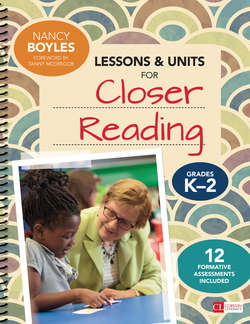Читать книгу Lessons and Units for Closer Reading, Grades K-2 - Nancy Boyles - Страница 27
На сайте Литреса книга снята с продажи.
Tips for Success
ОглавлениеAlone or with colleagues, brainstorm all the learning pathways you might want to construct in the primary grades. For example, in this book I’ve addressed how to study about a person, an animal, a place, a theme, or a character trait. But this is just a beginning! You could design a learning pathway on a current issue or on something that resonates in your community or state.
Framing your unit teaching in terms of learning pathways is the gift that keeps on giving. Here’s why: The first time you study an animal (or whatever) with your students, you begin to forge this pathway. The next time animal study comes up in a unit, or even in an individual text, students have a bit of a foundation on which to build—so your job is a little easier, and students are a lot more engaged. To get you thinking about the kinds of questions that could work over and over again across units, ask, “What are some questions we always need to answer when we’re studying an animal? How do we begin? What kinds of resources might help us?”
Just imagine the independent close reading we would see in our students if teachers of every grade worked together to build these pathways. Instead of a learning pathway, we’d have a learning superhighway. And by the end of high school, we’d most certainly have kids who are college and career ready. College may seem a long way off when we’re teaching kindergarten or first or second grade. But close reading can support literacy right from the start. Close reading taught really, really well can help students achieve standards—and so much more!
Here are the pathways, units, and anchor texts included in this book.
